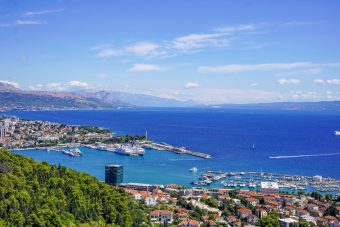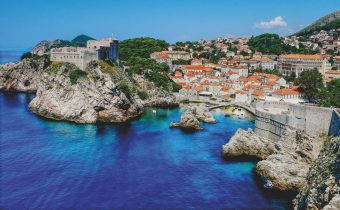
The Republic of Croatia has been strongly encouraging the use of renewable energy sources (RES) for some time now. According to EUROSTAT data for 2021, RES had a 31.3 per cent share in the country’s gross direct consumption. A new national goal of at least a 36.6 per cent share of renewable energy sources in the final gross energy consumption by 2030 has been set. The Croatian Ambassador to Serbia, H.E. Hidajet Biščević, told us that the European Parliament’s and European Council’s Directive 2018/2001 from 2018, which promotes the use of energy generated from renewable sources, was incorporated into the Croatian legislation when the country adopted the Law on Renewable Energy Sources and High-Efficiency Cogeneration.
“The law regulates issues important for implementing the energy transition towards the use of RES following the 2030 Energy Development Strategy with projections until 2050 and the Integrated National Energy and Climate Plan for Croatia, covering the period from 2021 to 2030. These are fundamental acts for implementing the energy policy in the part that specifically refers to the sale and use of renewable energy in the electricity and heat markets,” Ambassador Biščević said.
IN FOSUC:
- URBAN BEEKEEPING REQUIRES LOCAL INITIATIVE
- APPLICATION OF ENVIRONMENTALLY FRIENDLY MATERIALS IN CONTEMPORARY ARCHITECTURE
- WHAT IS YOUR CARBON FOOTPRINT?
How is the use of renewable sources regulated by the Law on Renewable Energy Sources?

Transparent and unambiguous rules have been put in place to calculate the share of energy from renewable sources, define these sources, fulfil reporting obligations to the European Commission, as well as prescribing the possibility of cooperation on joint projects with other EU Member States and the statistical transfer of the share of renewable energy. The regulation also stipulates possibilities for incentivizing the use of renewable energy so that the shortcomings of the energy market in the development of new production facilities are eliminated, and clear rules, scope and dynamics of support are implemented following the possibilities of planning the development, construction, and modernization of energy systems. A straightforward procedure for the certification of privileged energy producers is implemented too. It prescribes drafting a manual on administrative procedures and obtaining permits to construct facilities to produce energy from renewable sources. It regulates issues of guarantee of origin, establishing and managing a renewable energy sources register, transferring energy from RES to gas and heating systems, and increasing use in the heating and cooling sector.
How much the country subsidizes projects related to the use of solar, geothermal and sea energy?
Croatia plans to continue providing incentives for the production of electricity from RES until 2030 to reduce CO2 emissions in the energy sector, which also implies increasing production and ensuring a greater quantity of electricity for the country’s needs. Croatia has to improve its power system to achieve that goal and meet all the technical prerequisites for the planned growth.
The National Recovery and Resilience Plan foresees allocation of 400 million euros for the revitalization, modernization, and digitization of the electric power system. In this way, better access to new power plants will facilitate electricity production capacity from renewable sources by 1,500 MW by the end of 2024. There is also the Modernization Fund intended for the decarbonization of industry in the form of support for investments in the modernization of the energy system and the improvement of energy efficiency.
In the new Competitiveness and Cohesion Programme covering the financial period from 2021 to 2027, 279 million euros have been allocated for the energy sector, including micro solar plants and heat pumps. The funds are intended for citizens to ensure their self-sustainability energy-wise while reducing financial expenses for energy consumption in households.
How much did EU membership contribute to Croatia’s environmental protection and sustainable development progress?

At the time when the country was in the process of joining the EU, Croatia used a lot of technical assistance from TAIEX in the transfer of the know-how related to climate change needed for the establishment of the EU system of trading, monitoring and reporting on greenhouse gas emissions (EU ETS).
We have also established important cooperation with Slovenia due to the smaller language barrier. Even after Croatia joined the EU, the TAEIX instrument was still used to implement EU legislation. During the adoption and implementation of EU legislation, the Member States participate in the Commission’s technical meetings where the fulfilment of all obligations, including the new ones prescribed by secondary EU legislation, are discussed. It is a good opportunity to exchange experiences and best practices, contributing to successfully implementing environmental protection and sustainable development policies.
Croatia is strategically focused on clean energy, but you are partly supplied with electricity from the Krško nuclear power plant. What is the future of this power plant?
Croatia has been investing a lot of effort into incentivizing energy production from renewable sources and new technologies and developing a grid to transfer this energy. We own half of the nuclear power plant in Slovenia, and Croatia has nothing against nuclear energy as a low-carbon energy source. About 16 per cent of our electricity is produced by the Krško nuclear power plant, and we are interested in being included in the Krško 2 project if the Slovenian side decides to invite us. We believe nuclear energy is clean energy, doesn’t produce CO2 emissions, and can significantly contribute to reaching our climate goals and decarbonizing the economy.
Interviewed by: Mirjana Vujadinović Tomevski
Read the story in the new issue of the Energy portal Magazine RENEWABLE ENERGY SOURCES



